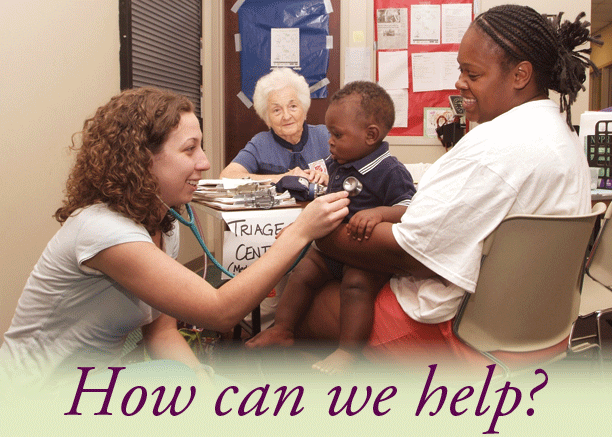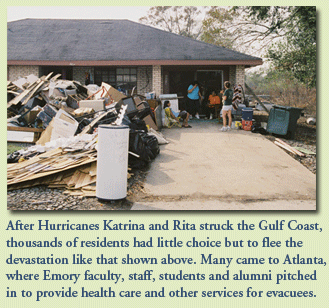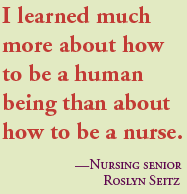













|
 |
| |
|
|
 |
Graduate
student Deena Yowler checks a baby’s heart rate at the Salvation
Army shelter near Emory. School of Nursing volunteers like Yowler
and retired faculty member Elizabeth Mabry (shown in the background)
helped staff the shelter 24/7 to assist Hurricane Katrina evacuees
seeking refuge in Atlanta. |
 |
| |
|
|
| |
 hough
several months have passed since Hurricanes Katrina and Rita bore
down on the Gulf Coast, the images of human suffering and physical
devastation remain etched in heart and mind. When news of the hurricane
disaster spread across Emory and the School of Nursing, the question
arose quickly: How can we help? hough
several months have passed since Hurricanes Katrina and Rita bore
down on the Gulf Coast, the images of human suffering and physical
devastation remain etched in heart and mind. When news of the hurricane
disaster spread across Emory and the School of Nursing, the question
arose quickly: How can we help?
Once hurricane evacuees began
arriving in Atlanta, the School of Nursing joined with colleagues
in the Woodruff Health Sciences Center and the university to provide
care and comfort. The day after Katrina struck last August, the
Emory Student Nurses’ Association (ESNA) began collecting
donations for the American Red Cross and  signed
up students for community service. “As human beings, but even
more so as student nurses, we felt the need to do something right
away,” says ESNA president Anjli Aurora. signed
up students for community service. “As human beings, but even
more so as student nurses, we felt the need to do something right
away,” says ESNA president Anjli Aurora.
ESNA members were among the numerous
students, faculty, and alumni serving at Red Cross shelters throughout
metro Atlanta. Lauren Jo Singletary, a graduate student in the Public
Health Nursing Leadership Program, had just begun her clinical rotation
at Atlanta’s Red Cross headquarters when evacuees from Hurricane
Katrina began to arrive. She spent one day interviewing family members
and providing them with information at a Red Cross service center
in Cobb County. Back at Red Cross headquarters, she helped prepare
a manifest of evacuees detailing where they went for treatment or
where and with whom they stayed in Atlanta.
“What touched me the most is
how thousands of people came to the Atlanta area seeking shelter,”
says Singletary, who also works in the oncology/bone marrow transplant
unit at Emory University Hospital. “I walked out of Red Cross
headquarters on a Sunday afternoon, and there were hundreds of people—families,
children, individuals—waiting in the heat, seeking food and
shelter. My heart went out to these people. All I wanted to do was
help.”
Elizabeth Downes, clinical assistant
professor, volunteered at several Red Cross locations, helping evacuees
obtain medications, checking blood pressure and blood glucose levels,
applying or changing dressings, and referring patients, including
a woman in labor. Downes worked alongside recent nursing school
graduates, whose numbers were still programmed into her cell phone.
When she called them for help, they showed up ready to go, Downes
says.
Nursing school volunteers assisted
in other ways. Senior Lisa Thomas rearranged her class schedule
to help her father, also a nurse, in her native New Orleans. Still
others volunteered at the Salvation Army shelter near Emory, which
the university adopted when the full extent of evacuees’ needs
became apparent.
“All of us had been watching
the news coverage of Katrina. But over the first couple of days
when the levees broke in New Orleans, when Atlanta started getting
medical evacuees coming in through Dobbins Air Reserve Base, we
started to see how bad things were,” recalls Wendy Rhein,
director of service learning for the nursing school. “A group
of us from all different sections of the university banded together
as a hurricane response network. We talked twice a day in conference
calls about what we were going to do and what we were capable of
doing.”
Rhein, along with Dr. Maureen Kelley,
chair of the Department of Family and Community Nursing, and Dr.
Charles Harper, a School of Medicine faculty member in charge of
clinical care at various relief  shelters,
visited the Salvation Army site to offer help and committed to providing
nursing support for as long as the shelter was open. “As a
school, we dispatched nurses, faculty, alumni, and undergraduate
students, who provided care and support 24/7 in addition to taking
health histories,” says Rhein. shelters,
visited the Salvation Army site to offer help and committed to providing
nursing support for as long as the shelter was open. “As a
school, we dispatched nurses, faculty, alumni, and undergraduate
students, who provided care and support 24/7 in addition to taking
health histories,” says Rhein.
Nursing senior Roslyn Seitz had worked
at the Red Cross shelter in Covington, Georgia, when the call for
volunteers to staff the Salvation Army shelter went out. “In
the days after Katrina, I remember feeling completely powerless
to help the people who were suffering,” says Seitz, who holds
an Emory master’s degree in public health. “Volunteering
in the shelters around Atlanta was a way for me to make a difference
and show I cared.”
Like other volunteers, Seitz pitched
in as needed. At the Covington shelter, she unloaded food from trucks,
helped with a public health survey, and coaxed a donated computer
into providing Internet access for evacuees. At the Salvation Army
shelter, she interviewed evacuees, took vital signs, assisted in
wound care, picked up medications for evacuees from a pharmacy,
and assisted with organizational tasks. Most important, she tried
to provide evacuees with a sense of hope.
“I tried to follow through with
the smaller things at the shelter to keep their spirits up,”
says Seitz, who plans to become a family nurse practitioner. “Having
a continuing presence was important.
The situation was truly chaotic for them. Many had stayed in different
shelters, waited in different lines, watched volunteer staff come
and go, and already had many promises of help broken. Just being
there every day and sitting with them to give a sense of continuity
and stability was the most important thing I could do.”
For two weeks straight, nursing and
medical school volunteers staffed the shelter around the clock until
it closed. By then, the Salvation Army had found permanent homes
for all of its evacuees. The shelter’s efforts—and Emory’s—were
not lost on Maureen Kelley, who put in her share of hours at the
site.
“The relief effort was collaboration
at its best—all units working together with a common goal
to ‘be there,’ ” she says. “Nurses and students provided a 24-hour presence at the shelter, which created
a strong connection with the families housed there. The Salvation
Army was amazing. It is an organization that never forgets human
suffering.”
students provided a 24-hour presence at the shelter, which created
a strong connection with the families housed there. The Salvation
Army was amazing. It is an organization that never forgets human
suffering.”
All told, School of Nursing students,
faculty, and alumni logged 362 volunteer hours at the shelter. Through
the Health Sciences Center, the school was part of an unprecedented
effort in terms of the number of Emory community members providing
care and the number of people they aided. Once the immediate crisis
of providing assistance passed, more than 150 evacuees from Katrina
were admitted as inpatients at Emory or Emory-affiliated hospitals
(including Grady), while more than 800 were treated as outpatients.
In addition, Emory physicians, residents, nurses, and students cared
for hundreds of other patients at shelters and centers across metro
Atlanta. Another dozen inpatients from Hurricane Rita also received
care.
Given the extent of the suffering
caused by both hurricanes, the storms provided a lasting real-world
lesson in service to others, something the School of Nursing seeks
to instill in every student.
“The experience was stressful, emotionally exhausting, and
wonderful all at the same time,” says Seitz. “I learned
much more about how to be a human being than about how to be a nurse.”
Downes believes much work remains
to help the storms’ victims. “I have seen thousands
of displaced persons receiving emergency supplies, medical care,
and clean water,” says Downes of her disaster relief experiences
in other countries. “We in Atlanta did what we could, but
the horrors of Katrina could have been mitigated. I can only hope
we learn lessons from it, but thousands of people are still homeless.
The ‘relief’ is not over.”
—Pam
Auchmutey and Robin Tricoles |
|
| |
|
|
| |
|
|
|
|
|